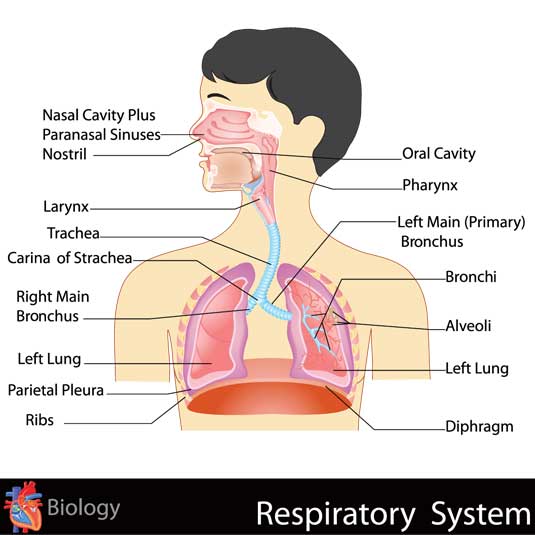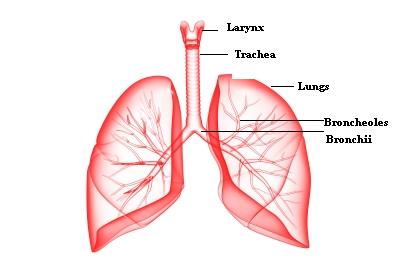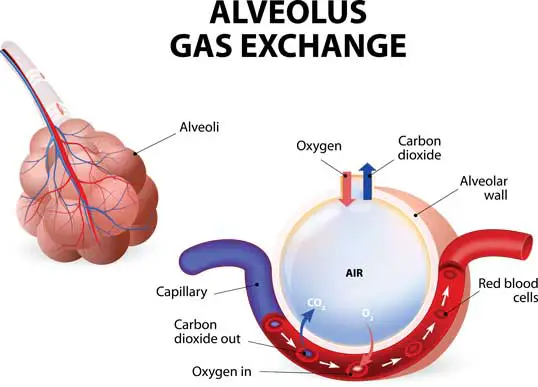The respiratory system is one of the 11 organ systems of the body.
It helps in the safe intake of air from the atmosphere into the body to generate life energy.
We breathe in oxygen-rich air through the process of inspiration and breathe out air rich in CO2 by expiration.
This respiratory system helps efficiently exchange gases between the body and the outer atmosphere.
The physiology of the respiratory system is a continuous and robust activity.
But it is a delicate one, and if neglected or hampered in early life, it can drastically reduce the life span and quality of life.
There are many disorders of the respiratory system. However, they are not instantly fatal.
So they can be managed and treated properly.
Anatomy and Physiology of Respiratory System | Main Parts
The respiratory system parts consist of
- Nose
- Pharynx
- Larynx
- Trachea
- Two bronchi
- Bronchioles
- Two lungs (with alveoli inside).
- Diaphragm and inter-coastal muscles.

Nose
- This is the starting point of the pulmonary system and is exposed to the external environment.
- It is the entry and exit route of the air into and out of the body, respectively.
- The nasal cavity is partly made of cartilaginous bone and skull bone. It is divided by the septum into two equal passages for air.
- It has olfactory receptors at the roof in the nostril’s walls. Also, there is a small tuft of hair inside to entrap any dust particles passing along with the air.
Pharynx
- This is present immediately after the nose.
- This is a tube approximately 14 centimeters long.
- It starts from the base of the skull and ends at the level of the 6th cervical vertebra (neck region).
- It is divided into three parts: nasopharynx, oropharynx, and laryngopharynx.
- It is a common channel for both the digestive and respiratory systems.
- It is divided into three parts: nasopharynx, oropharynx, and laryngopharynx.
Larynx
- This is the tract of the respiratory system in the throat.
- It is responsible for sound and is made of cartilage.
Trachea
- This is a longer part of the track and is made of circles of cartilaginous bones that can contract and relax.
- This trachea divides into two bronchi before entry into the lungs.
Bronchi
- These are two of them, the right and left, and each enters into the respective lung.
- Bronchi further divide into smaller branches as bronchioles, which almost extend into the lungs’ alveoli.
- Both trachea and bronchi are hollow organs that enable the free flow of air.
Lungs

- These are important organs of the respiratory anatomy.
- Here, the actual process of respiration occurs. They are large sac-like structures (balloon-like).
- There are two in number, with one on the left side and others on the right of the thorax or chest.
- They are very thin, layered, and a bit transparent. Their walls have many passing tiny blood vessels.
- They are very delicate to sharp objects and get punctured easily on an injury.
- Inside these lungs are small sacs called alveoli, which exchange gases between blood and air.
Alveoli:

- Alveoli are the air sacs in the lungs, and each lung has approximately 150 million alveoli in a healthy adult.
- The alveoli have thin walls and are surrounded by a network of blood capillaries.
- There is a surfactant, a phospholipid fluid in alveoli that helps reduce surface tension, thereby maintaining alveolar size and preventing collapse during expiration.
Diaphragm
- This is a skeletal muscle present below the lungs.
- It lies horizontally and separates the respiratory cavity from the abdominal cavity.
Respiratory system accessories
Cilia
- These are tiny bristle-like structures on the surface of the respiratory tract.
- They help move dust and phlegm from inside to outside of the track.
They move in one specific direction only.
In older people and people with inflammation, the cilia activity is low; hence, phlegm accumulates a lot in their respiratory tract.

Phlegm
- Phlegm is a mucous secretion in the respiratory tract aimed to keep the tract moist and remove any dust particles that enter the tract by flowing toward the nose.
- Cilia on the surface of the tract help this movement of phlegm. However, profuse secretion and accumulation of mucus can cause havoc in patients.
👉Read the difference between anatomy vs. physiology.
Functions of the Respiratory Organs
Nose functions
- It is the starting part of the respiratory system and opens directly to the atmosphere.
- It allows the passage of air into the respiratory tract.
- It ensures that air is not irritating and no particles pass into the tract.
a) Sense of smell:
- Olfactory function is one of the key functions of the nose.
- The olfactory nerves begin from the nasal roof to form an olfactory bulb.
- From here, the information of the sense of smell is carried into the olfactory lobe and then to the brain for perception.
b) Warming the passing air:
- When air enters the nose, the mucous wall in the nose comes into contact.
- Due to the high blood supply to this layer, the air gets warmed.
c) Cleaning and filtering:
- The air might have bacteria and dust particles. These are trapped in the nose.
- Hair in the nose traps large particles, while the moist mucosa traps bacteria and small dust particles.
d) Moistening:
- When air travels over the mucous layer, the moisture present saturates the air with water vapor.
Pharynx function
1. It helps in the passage of air and food.
2. Warms and humidifies the air.
3. Protection against microbes by producing antigens from the tonsils.
4. In speech production, it helps to resonate sound coming from the larynx.
Physiology of the respiratory system
The respiratory system plays an important role in maintaining body homeostasis in terms of oxygen, CO2 levels.
Gaseous exchange:
- It helps intake oxygen (O2) into the blood from the atmosphere and leaves out CO2.

Nervous control: Both involuntary and voluntary control.
- It is under involuntary control by the sympathetic and parasympathetic nervous systems.
- However, partial voluntary control is also possible due to the thoracic and diaphragm skeletal muscles.
- The sympathetic nervous system helps dilate bronchi, allowing larger air intake volumes.
- The parasympathetic system helps in the contraction of muscles and the expelling of gases from the lungs.
Metabolism:
- Some drugs and substances metabolize in the lungs due to heavy O2 content.
Excretory in function:
- Lungs help to excrete gaseous or volatile substances like Ammonia (NH3), Alcohol, etc.
- Hence, when one drinks alcohol, its odor is detected in the breath, and breath analyzers are used to test drivers on the road.
FAQs
How does the diaphragm help with breathing
The diaphragm is a thin skeletal muscle below the lungs.
👉 It contracts downwards, creating negative lung pressure to rush into the air.
👉 It also relaxes moving upwards and helps in expiration by contraction of the lungs.
👉 When required, it can also help in coughing for forceful expulsion of dust from the respiratory tract.
thank for letting me use the web to look for answers
I want to cite material used in this site for a Biology paper, can you provide me with the correct citation, thank you
Hi, you can site as author: ranga.nr, with DOP as January 2019.